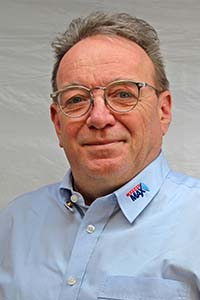From primer fillers and primers to base coats and top coats
1K or 2K products - even large parts can be painted
without any problems, you just have to follow a few tips

As with spray painting, the preparation of the substrate is crucial. Surfaces to be painted must be clean, dry and free of grease. Ralf Ertle emphasises: "Even though there is less overspray with spray can painting: Everything that is not to be painted must be covered with tape and paper."
To ensure the best possible application of the material from the can, the spray can must be shaken before use. Ertle elaborates, "After the substrate has been prepared in the usual way, the spray can must be shaken thoroughly for about two minutes after the mixing ball has been struck." This ensures that the product in the can is optimally mixed and the paint application appears even.
In contrast to the spray gun, where the optimum distance to the object is defined when painting, it is worthwhile to test-spray on a practice area when spray-can painting: "This way, the painter can see how the spray jet comes out of the can and spreads over the surface and, above all, what distance he has to keep from the object," explains Ertle.
When painting, the spray can should always be held vertically. The spray pass starts outside the object. "It is best to spray several thin coats in a criss-cross pattern, first vertically, then horizontally. Wait two to three minutes in between," the expert recommends. The ideal working temperature is between 20 and 25 degrees Celsius.
How do 2-component spray paints work? With the SprayMax products from Kwasny, hardener is in a separate cartridge inside the can. By pressing a special attachment firmly onto the bottom of the can, the inner sleeve is pushed through. "This allows the hardener and active ingredient in the can to come into contact," Ertle points out.
SprayMax offers specialist companies a modular, graduated introduction to the topic of paint repair. Depending on the personnel situation, the workplaces available or to be set up and the customer structure, the scope of paint repair can be selected by the company and the user. The seminars and practical training courses support the entry into or expansion of this business field through accompanying courses and applications. The interested party can choose between different course contents, scope and duration.
In the technical centre, which was specially developed and built for customer training, the participants learn about the different course contents in small groups in a relaxed atmosphere, depending on the training chosen. The participants are trained in both theory and practice by experienced staff. Interesting discussions and starting points often arise. Certainly, however, one or the other "secret tip" is exchanged at each course, to the benefit of all.
Objective
The objective of the intensive training is to learn and train the application of the SprayMax system and to enable the participants to repair classic spot repair damage after this training.
Target group
Companies and users who want to start classical spot repair with aerosol cans and who want to do it in addition to their existing business.
Course contents
Duration
1 day | 9.00 hrs to approx. 16.00 hrs
Dates
On request
Participants / number of participants
The participants will independently repair classic SpotRepair damage to the vehicle under individual instruction. In all details and all process steps. Each participant has a workstation and their own training parts.
The maximum number of participants is therefore 4.
Practical seminar Spot Repair Basic
The aim of the seminar is to independently repair classic minor damage to the vehicle with the SprayMax© system. In addition, the participants will learn how to use the new SprayMax© UV repair system and how to recondition headlights.
Companies and users who already have painting experience, refurbishers/converters
EXCERPT:
2 days | 9.00 a.m. to approx. 4.00 p.m.
On request
The participants will independently repair classic SpotRepair damage under individual guidance. In all details and all process steps. Each participant has a workstation and their own training parts.
The maximum number of participants is therefore 4.
The aim of the live demonstration is to carry out a professional and durable reconditioning of headlights with plastic lenses.
Painters/refurbishers/retailers
1 to 2 hours. Depending on the type of damage and questions of the participants.
On request
The number of participants depends on the group of participants, the location and the respective hygiene regulations and the type of participation.
(on site or via live video stream*)
The objective of the live demonstration is to provide a decision-making basis for the introduction and scope of UV repair systems.
Coaters/refinishers/converters
Companies and users who want to carry out spot repair with UV-curing products or who already use
UV products in the liquid coating sector but would like to supplement and expand the area of application with
aerosol solutions.
1 to 2 hours. Depending on the type of damage and questions of the participants.
On request
The number of participants depends on the group of participants, the location and the respective hygiene regulations and the type of participation.
(on site or via live video stream*)